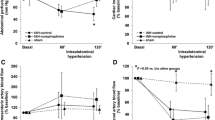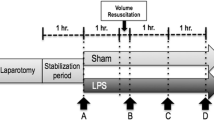Abstract
We studied the effects of two catecholamines with differing receptor profiles on hepatic blood flow and hepatic structure in a porcine model of faecal peritonitis. We treated animals with dopexamine (group Dp) or dobutamine (group Db) and fluid, or fluid alone as a control, to achieve a 2.5% increase in Qt from baseline values. After the induction of faecal peritonitis the increased Qt was maintained throughout the 8 h study period by adjustment of the fluid infusion rate. The dose of catecholamines remained constant. Hepatic blood flow was correspondingly maintained at above baseline values throughout the study. Post-mortem liver biopsy specimens were analysed from experimental animals and t sham animals who had not been instrumented or infected. In experimental animals there was a reduction in sinusoidal patency between sham and group Dp (76% of total sinusoid vs 51%,p<0.05) and group Dp and control (51% vs 33%,p<0.05) or groups Dp and Db (51% vs 34%,p<0,05) animals. This was accounted for by an increase in sinusoidal leukocytes and endothelial swelling. In addition to the changes noted above there was marked hepatocellular destruction in group Db. We conclude that maintenance of organ blood flow does not guarantee structural integrity in the sepsis syndrome and hepatocellular damage was greater in group Db than group Dp or control.
Similar content being viewed by others
References
Knaus WA, Draper EA, Wagner DP, Zimmerman JE (1985) Prognosis in acute organ-system failure. Ann Surg 202:685–693
Danek SJ, Lynch JP, Weg JC, Dantzker DR (1980) The dependence of oxygen uptake on oxygen delivery in the adult respiratory distress syndrome. Am Rev Respir Dis 122:387–395
Tighe D, Moss RF, Boghossian S, Heath MF, Chessum B, Bennett ED (1989) Multi-organ damage resulting from experimental faecal peritonitis. Clin Sci 76:269–276
Champion HR, Jones RT, Trump BF, Decker F, Wilson S, Miginski M, Gill W (1976) A clinicopathologic study of hepatic dysfunction following shock. Surg Gynecol Obstet 142:657–663
Rangel DM, Byfield JE, Adomian GE, Stevens GH, Fonkalsrud EW (1970) Hepatic ultrastructural response to endotoxin shock. Surgery 68:503–511
Sato T, Tanaka J, Kono Y, Jones RT, Cowley RA, Trump BF (1982) Hepatic cellular injury following lethalEscherichia coli bacteremia in rats. Lab Invest 47:304–310
Shoemaker WC, Appel PL, Waxman K, Schwartz S, Chang P (1982) Clinical trial of survivor's cardiorespiratory patterns as therapeutic goals in critically ill postoperative patients. Crit Care Med 10:398–403
Shoemaker WC, Appel PL, Kram HB, Waxman K, Lee TS (1988) Prospective trail of supranormal values of survivors as therapeutic goals in high-risk surgical patients. Chest 94:1176–1186
Edwards JD, Brown CS, Nightingale P, Slater R, Farragher EB (1989) Use of survivor's cardio-respiratory values as therapeutic goals in septic shock. Crit Care Med 17:1098–1103
Leier CV, Heban PT, Huss P (1978) Comparative systemic and regional haemodynamic effects of dopamine and dobutamine in patients with cardiomyopathic heart failure. Circulation 58:466–475
Brown RA, Dixon J and Farmer JB, Hall JC, Humphries RG, Ince F, O'Connor SE, Simpson WT, Smith GW (1985) Dopexamine: a novel agonist at peripheral dopamine receptors and β2-adrenoreceptors. Br J Pharmacol 85:599–608
Tighe D, Moss R, Hynd J, Boghossian S, Al-Saady N, Heath M, Bennett ED (1990) Pretreatment with pentoxyfilline improves the hemodynamic and histologic changes and decreases neutrophil adhesiveness in a pig fecal peritonitis model. Crit Care Med 18:184–189
Delesse MA (1847) Procédé mécanique pour déterminer la composition des roches. Comp Rend Acad Sci 25:544
Coalson JJ, Archer LT, Hall NK, Kern JD, Benjamin BA, Beller-Todd B, Hinshaw LB (1979) Prolonged shock in the monkey following liveE. coli organism infusion. Circ Shock 6:343–355
Trump BF, Berezesky IK, Cowley RA, (1982) The cellular and subcellular characteristics of acute and chronic injury with emphasis on the role of calcium. In: Cowley RA, Trump BF (eds) Pathology of shock, anoxia and ischemia. Williams and Wilkins, Baltimore, pp 6–46
White RR, Mela L, Bacalzo LV, Olofsson K, Miller LD (1973) Hepatic ultrastructure uin endotoxemia, hemorrhage, and hypoxia: emphasis on mitochondrial changes. Surgery 73:525–534
Arstila AU, Shelburne JD, Trump BF (1972) Studies on cellular autophagocytosis: a histochemical study on sequential alterations of mitochondria in the glucagon-induced autophagic vacuoles of rat liver. Lab Invest 27:317–323
Author information
Authors and Affiliations
Rights and permissions
About this article
Cite this article
Webb, A.R., Moss, R.F., Tighe, D. et al. The effects of dobutamine, dopexamine and fluid on hepatic histological responses to porcine faecal peritonitis. Intensive Care Med 17, 487–493 (1991). https://doi.org/10.1007/BF01690774
Received:
Accepted:
Issue Date:
DOI: https://doi.org/10.1007/BF01690774




